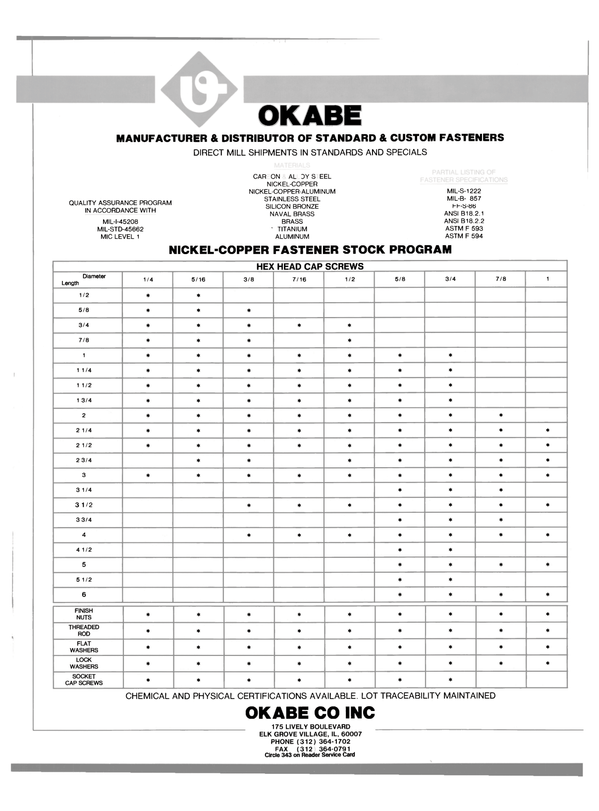
Crandall Railway System Again Proves Its Versatility/Dependability
The docking of the U.S. Navy's DDG-2 Adams on Atlantic Dry Dock's new 4,000-ton Crandall drydock shows once again the versatility of today's modern railway drydock.
To accommodate the locations and projections of the vessel's two sonar domes, the cradle had to be modified with the installation of a pit within its deck area to provide access for the after dome, while a gap was provided between the forward end of the main cradle and a detachable pony cradle to accommodate the forward dome. The vessel was docked on 9-foot-high steel keel block towers to provide the necessary docking clearances. The cradle, being 60 feet between uprights, allowed the vessel to enter the dock between the 9-foot-high keel block towers and the retracted sliding bilge blocks to its predetermined forward docking position. Once reached, the vessel was centered in the dock and secured for grounding.
The ability of the cradle to be modified easily to suit particular dockings proves once again that today's railway is still one of the most economical and secure means of drydocking and transferring vessels of up to 6,000 tons displacement.
For further information and free literature on railway and transfer systems from Crandall Dry Dock Engineers, Inc., Circle 25 on Reader Service Card
Read Crandall Railway System Again Proves Its Versatility/Dependability in Pdf, Flash or Html5 edition of November 1988 Maritime Reporter
Other stories from November 1988 issue
Content
- Program For U.S. Shipyard Revitalization Proposed page: 5
- $135-Million Luxury Cruise Vessel Ordered From Wartsila Marine By Finnish Shipowner Birka Line page: 6
- Newport News Announces Management Restructuring page: 7
- Moss Point Marine Completes Four-Ship U.S. Army Contract page: 8
- Joint Venture Formed To Build, Operate Passenger Submarines page: 8
- Anders Wilhelmsen Buys Royal Admiral page: 9
- Gladding-Hearn, LQMoffitt Develop Bearing Flange Design Solution page: 9
- Shrimper/Crabber Built By Mid-Coast Marine page: 10
- Omnithruster Waterjets Offer Maneuverability In Polar Regions page: 11
- World Orderbook Highest In Two Years page: 14
- Westmont Receives $24-Million Contract For Five Floating Cranes page: 14
- Colonna's Shipyard Elects Owen VP And GM page: 14
- Bender Delivers Two Factory Ships—Receives Contracts For Two More page: 15
- MMC International Announces New Tape And Valve Catalog page: 15
- Cargo Ship To Undergo $19.8-Million Conversion At Bay Shipbuilding page: 15
- McDermott International Forms Executive Operating Committee page: 16
- Nichols Bros. Wins $8-Million Contract To Build Six Ferries page: 16
- Non-Ferrous Offers Free Literature On Full Range Of Fasteners page: 17
- Falk Brochure Details Concentric Shaft Reducers page: 17
- SNAME 95th Annual Meeting and 7th International Maritime Exposition page: 20
- Mobile Telesystems Begins Operations page: 46
- New 42-Page Catalog On Flanged Ball Valve From Jamesbury page: 46
- Exxon Offers Exxcare— A Cost-Cutting Computerized Solution To Maintaining/Monitoring Oil page: 48
- Crandall Railway System Again Proves Its Versatility/Dependability page: 49
- Marine Travelift Brochure Describes Benefits Of BFM Mobile Boat Hoist Design page: 49
- Warren Screw Pump Meets High Viscosity Demands page: 50
- Nalfleet, Bull And Roberts Introduces New Approach To Water Treatment page: 52
- SPD Technologies Expands Through New Acquisitions And Product Development page: 56
- CALS Conference Slated For December 8 At USMMA-Kings Point page: 58
- Free Butterworth Brochure Details Types K/Super K Tank Cleaning Machines page: 58
- TBT-Containing Antifouling Paints —The Legislative Position— page: 59
- AT LAST, A GOVERNMENT PROGRAM THAT CAN BENEFIT ALL Implication of CALS to Industry page: 60
- OUTSTANDING WORKBOATS OF 1988 page: 62
- MAN B&W Engines Continue To Make Impact page: 71
- Gladding-Hearn Announces Sale Of Its Fourth INCAT To New York City Ferry Service page: 72
- Volvo Penta Engines Stipulated For Each Of Two 'Hybrid' Ships page: 72
- Port Of Iberia Acquires 70 Adjoining Acres In Master Development Plan page: 73
- Employee Buyout Helps Seattle Yard Emerge From Bankruptcy page: 74
- Hempel's Reports Good Response To New Cargo Barriers Coatings page: 74
- Stauff-Test Pressure Check System Developed By Stauff Corporation page: 75
- Safety Lifting Clamps For Plate And Structural Steel Featured In New Brochure page: 76
- Kiene Diesel Accessories' New Injector Puller Saves Time And Money page: 77
- New ARQ Radio Telex Station Offered By Hull page: 78
- Schroder Offers Six-Pcige Color Brochure On Marine Propulsion Control Systems page: 78
- Krupp MaK Wins $21.6-Million Retrofit Contract For Canadian Icebreaker page: 79
- Navy Approves PPG Coating To Stop Cable Fires page: 79
- Modern Cargo Pumps For Tankers And Barges page: 80
- Furuno Introduces High-Power FR-1500D Series Radar page: 82
- Acurex Introduces 'AutoNet'—Its Latest Portable Software System page: 82
- 75-Page Book On How To Survive Abandoning Ship Offered By Viking page: 83
- Tidewater Marine Adds Five M a r A d Vessels To Worldwide Fleet page: 84
- MAN B&W Diesel Introduces Two More Large Bore Engines page: 85
- Cospolich Develops Refrigerators With Extraordinary Capability page: 86
- New Rules To Mandate Sealing Of Barges page: 87
- Brochures From Hagglunds Describe Computerized Cargo Handling Systems page: 89
- Nichols To Build Advanced Technology 'Wave Piercer' For Fast Passenger Service page: 90
- Custom, Design-lt-Yourself Continuous Liquid Level Indicators Introduced By Gems page: 90
- Complicated RO/RO Conversions Completed By Danyard A /S page: 91
- B&W To Build 84,000-Dwt Products Carrier page: 91
- Bird-Johnson Names Vaughn Seattle Operation's Marketing And Sales Manager page: 93
- Harris SSB Radio Has Noise Blanker page: 94
- Sulzer-Powered French Containership Is Designed For Minimum Crewing page: 94
- Advanced Fiber Technology From Allied-Signal Division Improves Marine Rope Performance page: 99
- 'Space-Age' Simulator Program At MarineSafety Prepares Officers To Handle Super Containerships page: 106
- Munson Introduces Fast, Low-Wake Boat Designed For Harbor Commuter Routes page: 106
- AESA To Build Three More Reefers For Del Monte page: 107


